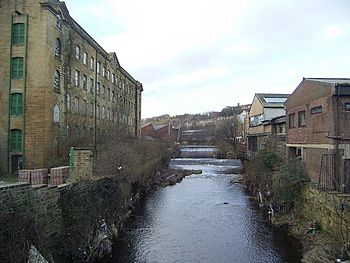River Colne, West Yorkshire facts for kids
Quick facts for kids River Colne |
|
|---|---|

The River Colne at the bottom of Chapel Hill just outside Huddersfield Town Centre. The mill on the left is Folly Hall Mill built in 1822 by Joseph Kaye.
|
|
| Country | England |
| Physical characteristics | |
| Main source | Confluence of Redbrook Clough and Haigh Clough 768 feet (234 m) 53°36′19″N 1°57′28″W / 53.60528°N 1.95778°W |
| River mouth | River Calder near Bradley 53°40′49″N 1°43′52″W / 53.68028°N 1.73111°W |
| Length | 12 miles (19 km) |
| Basin features | |
| Basin size | 95 square miles (245 km2) |
The River Colne is a river in West Yorkshire, England. It starts high up in the Pennines hills near Marsden. The river flows east through the Colne Valley and the town of Huddersfield. It then joins the larger River Calder at a place called Cooper Bridge.
Contents
Where the River Colne Flows
Rainwater collects high in the Pennines hills of West Yorkshire. This water forms small streams, known locally as cloughs. These streams flow down the hillsides. They fill reservoirs like March Haigh and Redbrook Reservoir.
Two main streams, Haigh Brook and Redbrook, continue flowing. They are joined by other smaller streams. Finally, they meet at a beautiful spot called Close Gate Bridge. This is where the River Colne officially begins.
The River Colne then travels from west to east through the Colne Valley. It passes through several towns and villages. These include Marsden, Slaithwaite, and Milnsbridge. It then reaches the big town of Huddersfield.
After Huddersfield, the river continues to Cooper Bridge. Here, it flows into the River Calder. The River Colne has several smaller rivers and streams that flow into it. These are called tributaries. Some of its tributaries are Wessenden Brook, Bradley Brook, Crimble Brook, Mag Brook, Fenay Brook, New Mill Dike, and the River Holme.
History of the Colne Valley
The Colne Valley was once very famous for making cloth. People produced high-quality woollen and cotton fabrics here. This was partly because of the River Colne. The river and its streams had soft, slightly acidic water. This water came from the peat moors high up in the hills. It was perfect for cleaning and processing wool and cotton.
Buildings and Transport Along the River
Many important things follow the path of the River Colne through the valley. The Huddersfield Narrow Canal runs alongside the river. This canal was built to transport goods. The Huddersfield Line railway also follows the river's route. This railway connects towns and cities. The A62 road is another important route that runs next to the river.
The River Colne itself is not deep enough for boats. It also has many rocks, so it cannot be used for water travel.
There are many factories and warehouses built along the river. These places make goods, offer services, and provide jobs for people. Sometimes, a few of these businesses can cause pollution. This pollution can affect the river and the local environment. To help stop this, the Environment Agency sets rules. They make sure that local companies meet certain standards to keep the water clean.
In 2010, there was an accident at a chemical factory. Some waste accidentally flowed into the river and the canal. This caused many fish to die.
See also
 In Spanish: Río Colne para niños
In Spanish: Río Colne para niños

